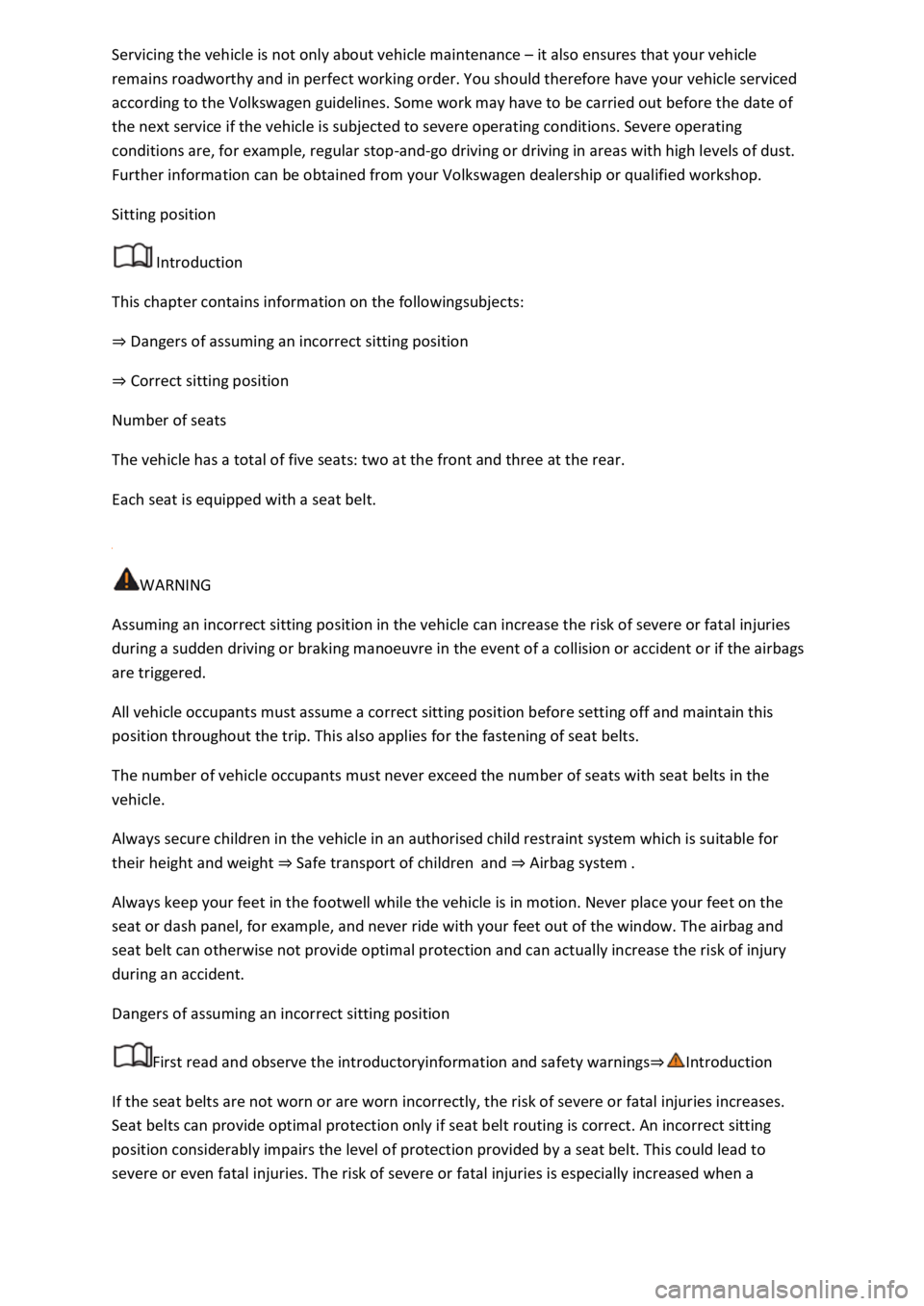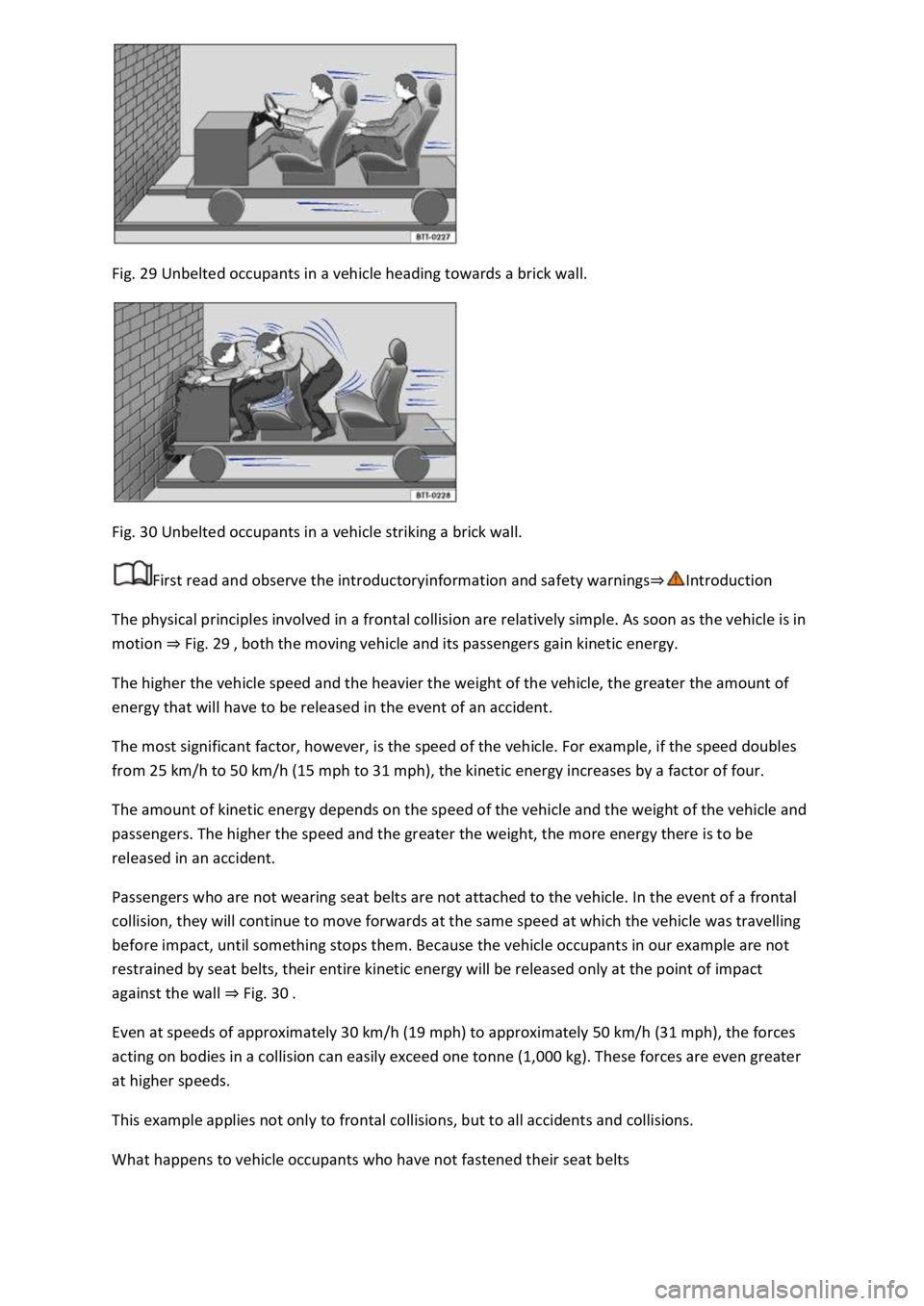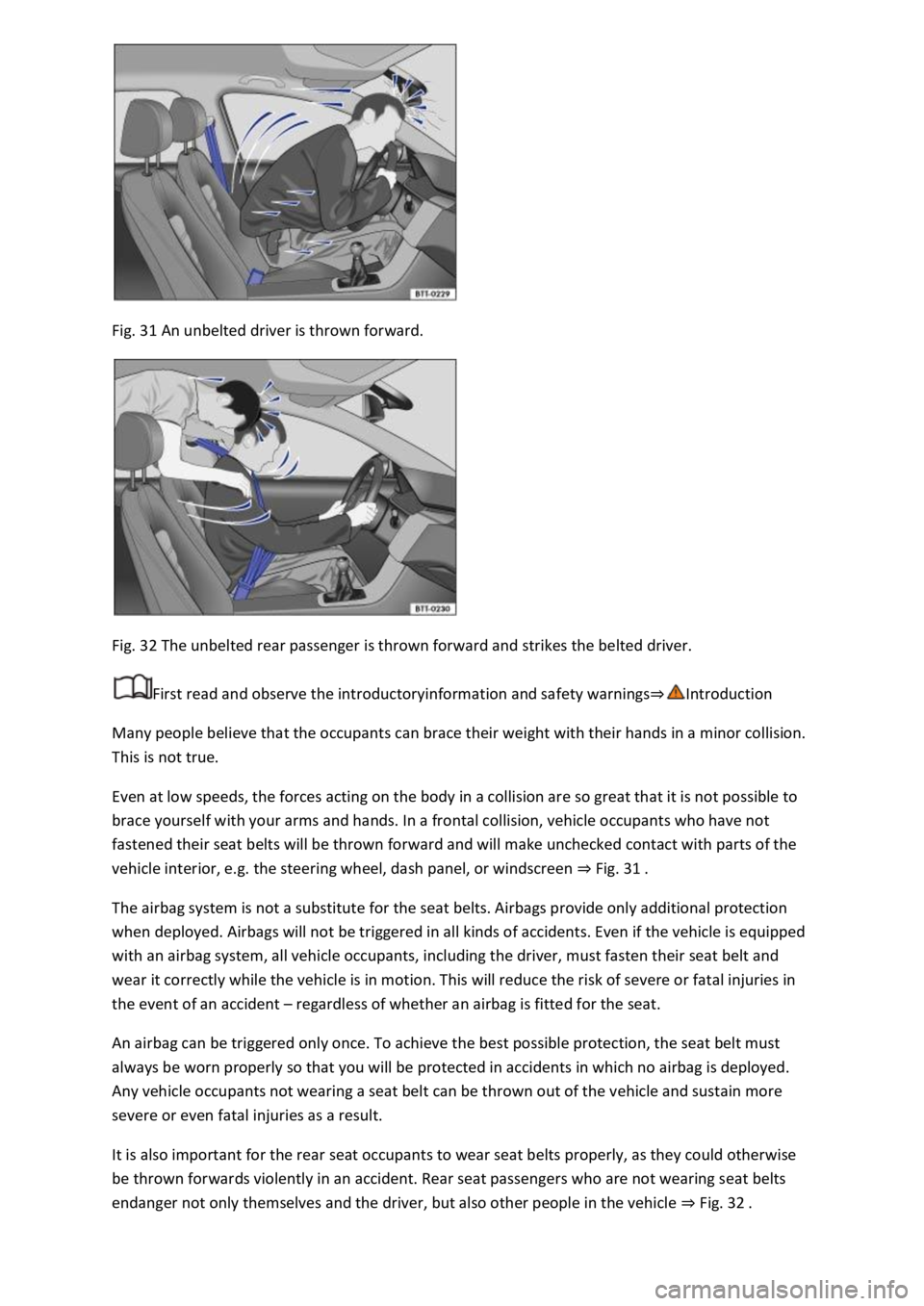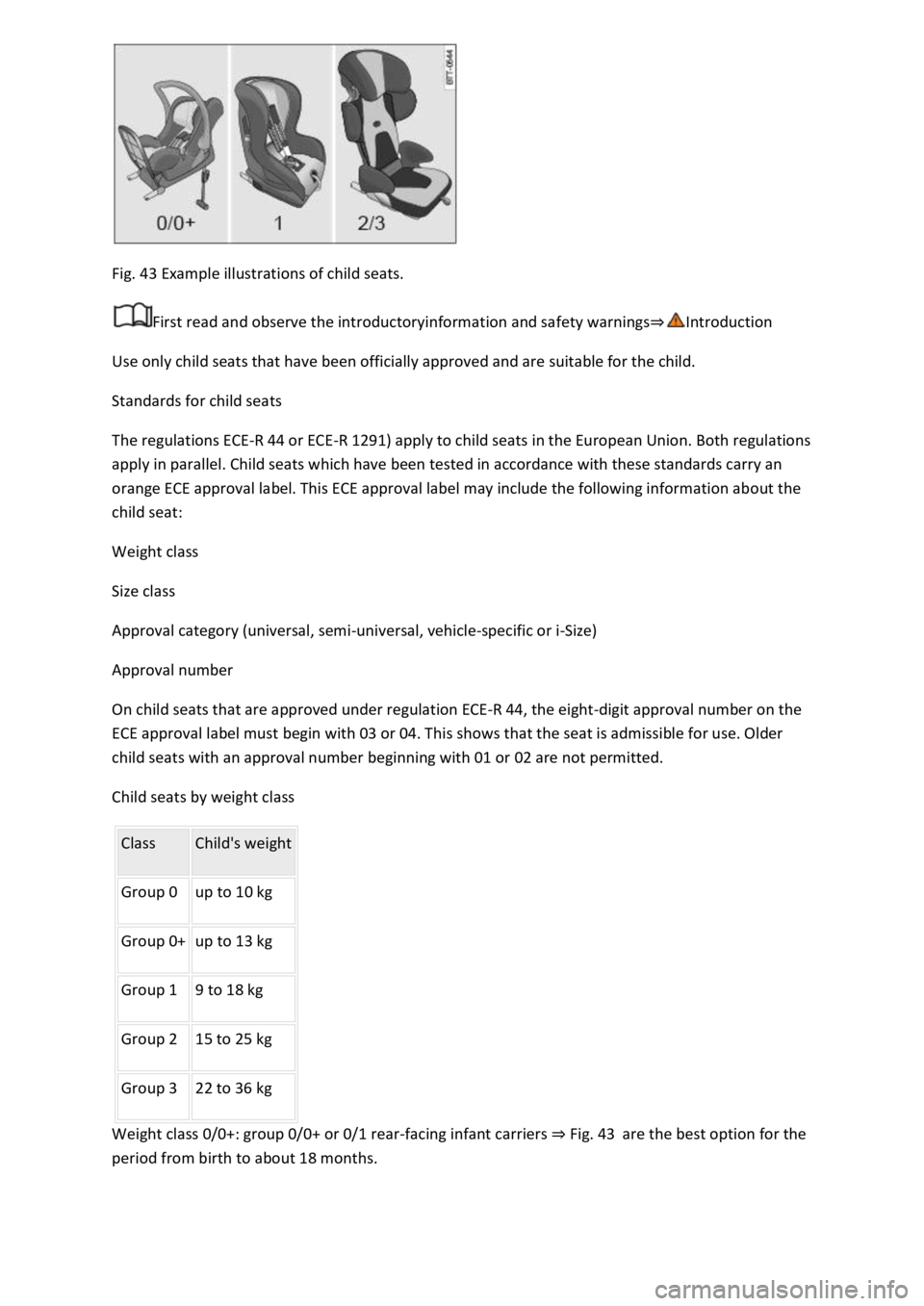2018 VOLKSWAGEN T-ROC weight
[x] Cancel search: weightPage 47 of 502

Checklist
Observe the following information both before and during every journey to ensure your own safety,
and the safety of all passengers and other road users
Check that all lights and turn signals are working properly.
Check the tyre pressure and fuel level Tyre pressure, Fuel gauge.
Check the washer fluid level Washer fluid.
Make sure that you have a good, clear view through all of the windows Caring for and cleaning the
vehicle exterior.
Secure any objects and luggage in the stowage compartments, the luggage compartment or on the
roof Transporting items.
Ensure that you are able to operate the pedals freely at all times.
Secure any children travelling in the vehicle in a restraint system suitable for their weight and size
Safe transport of children.
Adjust the front seats, head restraints and mirrors properly to match the size of the occupants
Sitting position, Mirrors.
Wear shoes that provide proper support for your feet when using the pedals.
The floor mat in the footwell on the driver side must leave the pedal area free and must be securely
fastened.
Page 48 of 502

sition before setting off and maintain this position while driving. This also
applies to all passengers Sitting position.
Fasten your seat belt correctly before setting off and keep it properly fastened throughout the
journey. This also applies to all passengers Seat belts.
Each vehicle occupant must sit in a seat of their own and must have their own seat belt.
Never drive if your driving ability is impaired, e.g. by medication, alcohol or drugs.
Do not allow yourself to be distracted from the traffic, e.g. by passengers, telephone calls, opening
menus and making adjustments to settings.
Always adapt your speed and driving style to suit visibility, weather, road and traffic conditions.
Observe traffic regulations and speed limits.
Take regular breaks when travelling long distances at least every two hours.
Secure animals in the vehicle using a system that is suitable for their weight and size.
Checklist
In some countries, special safety standards and emissions-related legislation apply that may differ
from the build status of the vehicle. Volkswagen recommends that you visit your Volkswagen
dealership before travelling abroad to find out about any legal requirements and the following issues
at your destination:
Does the vehicle need any technical modifications for driving abroad, e.g. masking or switching the
headlights over?
Are the necessary tools, diagnosis equipment and spare parts available for service and repair work?
Page 51 of 502

not only about vehicle maintenance it also ensures that your vehicle
remains roadworthy and in perfect working order. You should therefore have your vehicle serviced
according to the Volkswagen guidelines. Some work may have to be carried out before the date of
the next service if the vehicle is subjected to severe operating conditions. Severe operating
conditions are, for example, regular stop-and-go driving or driving in areas with high levels of dust.
Further information can be obtained from your Volkswagen dealership or qualified workshop.
Sitting position
Introduction
This chapter contains information on the followingsubjects:
Dangers of assuming an incorrect sitting position
Correct sitting posi
Number of seats
The vehicle has a total of five seats: two at the front and three at the rear.
Each seat is equipped with a seat belt.
WARNING
Assuming an incorrect sitting position in the vehicle can increase the risk of severe or fatal injuries
during a sudden driving or braking manoeuvre in the event of a collision or accident or if the airbags
are triggered.
All vehicle occupants must assume a correct sitting position before setting off and maintain this
position throughout the trip. This also applies for the fastening of seat belts.
The number of vehicle occupants must never exceed the number of seats with seat belts in the
vehicle.
Always secure children in the vehicle in an authorised child restraint system which is suitable for
their height and weight Safe transport of childrenand Airbag system
Always keep your feet in the footwell while the vehicle is in motion. Never place your feet on the
seat or dash panel, for example, and never ride with your feet out of the window. The airbag and
seat belt can otherwise not provide optimal protection and can actually increase the risk of injury
during an accident.
Dangers of assuming an incorrect sitting position
First read and observe the introductoryinformation and safety warnings
If the seat belts are not worn or are worn incorrectly, the risk of severe or fatal injuries increases.
Seat belts can provide optimal protection only if seat belt routing is correct. An incorrect sitting
position considerably impairs the level of protection provided by a seat belt. This could lead to
severe or even fatal injuries. The risk of severe or fatal injuries is especially increased when a
Page 55 of 502

seat belt belonging to their seat and keep it fastened properly throughout the trip. This applies to all
vehicle occupants and also in urban traffic.
While the vehicle is in motion, secure all children travelling in the vehicle in a restraint system
suitable for their weight and height. They must also wear correctly fastened seat belts Safe
transport of children
Drive off only when all passengers have correctly fastened their seat belts.
Never insert the latch plate into a buckle which does not belong to the corresponding seat and
always ensure it engages properly. Using a buckle which does not belong to the seat you are
occupying reduces the level of protection and can lead to severe injuries.
Never let any foreign bodies or liquids get into the slots for the belt buckles. This could prevent the
belt buckle and seat belt from working properly.
Never unfasten the seat belt while the vehicle is in motion.
Never allow more than one person to share the same seat belt.
Never travel when children or babies are being carried on somebody's lap and fastened with the
same belt.
Never travel wearing loose, bulky clothing (such as an overcoat over a jacket). This could prevent the
seat belts from fitting and functioning properly.
WARNING
Damaged seat belts are very dangerous and could cause severe or fatal injuries.
Never damage the belt by trapping it in the door or in the seat mechanism.
If the belt webbing or any other part of the seat belt becomes damaged, the seat belts may tear
during an accident or sudden braking manoeuvre.
Have damaged seat belts immediately replaced by new seat belts that have been approved by
Volkswagen for the vehicle. Seat belts subjected to stress and stretched during an accident must be
replaced by a qualified workshop. Renewal may be necessary even if there is no apparent damage.
The belt anchorage should also be checked.
Never try to repair, modify or remove the seat belts yourself. All repairs to the seat belts, belt
retractors and buckles must be carried out by a qualified workshop.
Warning lamp
Page 57 of 502

Fig. 29 Unbelted occupants in a vehicle heading towards a brick wall.
Fig. 30 Unbelted occupants in a vehicle striking a brick wall.
First read and observe the introductoryinformation and safety warnings
The physical principles involved in a frontal collision are relatively simple. As soon as the vehicle is in
motion Fig. 29
The higher the vehicle speed and the heavier the weight of the vehicle, the greater the amount of
energy that will have to be released in the event of an accident.
The most significant factor, however, is the speed of the vehicle. For example, if the speed doubles
from 25 km/h to 50 km/h (15 mph to 31 mph), the kinetic energy increases by a factor of four.
The amount of kinetic energy depends on the speed of the vehicle and the weight of the vehicle and
passengers. The higher the speed and the greater the weight, the more energy there is to be
released in an accident.
Passengers who are not wearing seat belts are not attached to the vehicle. In the event of a frontal
collision, they will continue to move forwards at the same speed at which the vehicle was travelling
before impact, until something stops them. Because the vehicle occupants in our example are not
restrained by seat belts, their entire kinetic energy will be released only at the point of impact
against the wall Fig. 30
Even at speeds of approximately 30 km/h (19 mph) to approximately 50 km/h (31 mph), the forces
acting on bodies in a collision can easily exceed one tonne (1,000 kg). These forces are even greater
at higher speeds.
This example applies not only to frontal collisions, but to all accidents and collisions.
What happens to vehicle occupants who have not fastened their seat belts
Page 58 of 502

Fig. 31 An unbelted driver is thrown forward.
Fig. 32 The unbelted rear passenger is thrown forward and strikes the belted driver.
First read and observe the introductoryinformation and safety warnings
Many people believe that the occupants can brace their weight with their hands in a minor collision.
This is not true.
Even at low speeds, the forces acting on the body in a collision are so great that it is not possible to
brace yourself with your arms and hands. In a frontal collision, vehicle occupants who have not
fastened their seat belts will be thrown forward and will make unchecked contact with parts of the
vehicle interior, e.g. the steering wheel, dash panel, or windscreen Fig. 31
The airbag system is not a substitute for the seat belts. Airbags provide only additional protection
when deployed. Airbags will not be triggered in all kinds of accidents. Even if the vehicle is equipped
with an airbag system, all vehicle occupants, including the driver, must fasten their seat belt and
wear it correctly while the vehicle is in motion. This will reduce the risk of severe or fatal injuries in
the event of an accident regardless of whether an airbag is fitted for the seat.
An airbag can be triggered only once. To achieve the best possible protection, the seat belt must
always be worn properly so that you will be protected in accidents in which no airbag is deployed.
Any vehicle occupants not wearing a seat belt can be thrown out of the vehicle and sustain more
severe or even fatal injuries as a result.
It is also important for the rear seat occupants to wear seat belts properly, as they could otherwise
be thrown forwards violently in an accident. Rear seat passengers who are not wearing seat belts
endanger not only themselves and the driver, but also other people in the vehicle Fig. 32
Page 76 of 502

seats when driving with children.
Note the following:
Child seats are classified into groups depending on the size, age and weight of child for which they
are designed.
Various securing systems are used to secure child seats in the vehicle.
For safety reasons, child seats must always be fitted to the rear seats Fitting and usi
Volkswagen recommends child seats from the Volkswagen range of accessories. These child seats
have been developed and approved for use in Volkswagen vehicles.
WARNING
If children are not secured or are inadequately secured, they are at greater risk of serious or even
fatal injury. Please note the following:
Children who are either under twelve years of age or less than 150 cm tall must not be carried in the
vehicle if they are not secured in a suitable child seat while the vehicle is in motion. Regulations in
some countries may differ and must be complied with.
Always secure children in the vehicle in a suitable child seat. The seat used must be appropriate to
the child's height, weight and age.
Never fasten more than one child into one child seat.
Under no circumstances should children or babies be held in a passenger's or drivers lap while
driving.
Never leave a child unsupervised in a child seat.
Never allow a child to be carried in a vehicle without being properly secured, and never allow a child
to stand up or to kneel on a seat, or to sit incorrectly while the car is in motion. This is particularly
important for children carried on the front passenger seat. In an accident, children may sustain
serious injuries to themselves and others.
The child seat can provide maximum protection only if the seat belt is routed correctly around it.
Always ensure that the seat belt is routed as specified in the instructions provided by the child seat
manufacturer. If the seat belt is routed incorrectly, injuries may occur even in a minor accident.
After an accident, it is vital to replace any child seats that were in use during the accident, as they
could have sustained non-visible damage.
Types of child seat
Page 77 of 502

Fig. 43 Example illustrations of child seats.
First read and observe the introductoryinformation and safety warnings
Use only child seats that have been officially approved and are suitable for the child.
Standards for child seats
The regulations ECE-R 44 or ECE-R 1291) apply to child seats in the European Union. Both regulations
apply in parallel. Child seats which have been tested in accordance with these standards carry an
orange ECE approval label. This ECE approval label may include the following information about the
child seat:
Weight class
Size class
Approval category (universal, semi-universal, vehicle-specific or i-Size)
Approval number
On child seats that are approved under regulation ECE-R 44, the eight-digit approval number on the
ECE approval label must begin with 03 or 04. This shows that the seat is admissible for use. Older
child seats with an approval number beginning with 01 or 02 are not permitted.
Child seats by weight class
Class Child's weight
Group 0 up to 10 kg
Group 0+ up to 13 kg
Group 1 9 to 18 kg
Group 2 15 to 25 kg
Group 3 22 to 36 kg
Weight class 0/0+: group 0/0+ or 0/1 rear-facing infant carriers Fig. 43are the best option for the
period from birth to about 18 months.